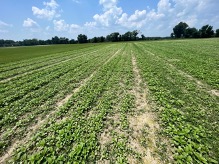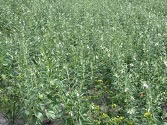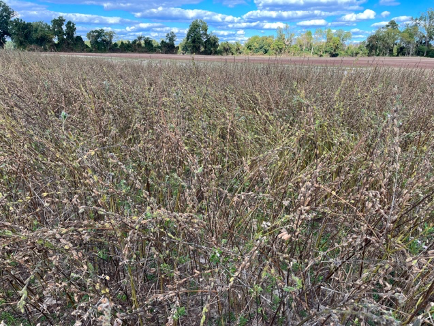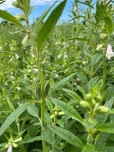Evaluation of Sesame Production Within Craven County, North Carolina
go.ncsu.edu/readext?966703
en Español / em Português
El inglés es el idioma de control de esta página. En la medida en que haya algún conflicto entre la traducción al inglés y la traducción, el inglés prevalece.
Al hacer clic en el enlace de traducción se activa un servicio de traducción gratuito para convertir la página al español. Al igual que con cualquier traducción por Internet, la conversión no es sensible al contexto y puede que no traduzca el texto en su significado original. NC State Extension no garantiza la exactitud del texto traducido. Por favor, tenga en cuenta que algunas aplicaciones y/o servicios pueden no funcionar como se espera cuando se traducen.
Português
Inglês é o idioma de controle desta página. Na medida que haja algum conflito entre o texto original em Inglês e a tradução, o Inglês prevalece.
Ao clicar no link de tradução, um serviço gratuito de tradução será ativado para converter a página para o Português. Como em qualquer tradução pela internet, a conversão não é sensivel ao contexto e pode não ocorrer a tradução para o significado orginal. O serviço de Extensão da Carolina do Norte (NC State Extension) não garante a exatidão do texto traduzido. Por favor, observe que algumas funções ou serviços podem não funcionar como esperado após a tradução.
English
English is the controlling language of this page. To the extent there is any conflict between the English text and the translation, English controls.
Clicking on the translation link activates a free translation service to convert the page to Spanish. As with any Internet translation, the conversion is not context-sensitive and may not translate the text to its original meaning. NC State Extension does not guarantee the accuracy of the translated text. Please note that some applications and/or services may not function as expected when translated.
Collapse ▲With limited, if any, sesame production along the coastal region of North Carolina, a grower examining potential sesame production may be uncertain as to whether the extremely humid climate, high population of insects, increased disease probability, and frequent occurrence of tropical storm systems will afford the opportunity to incorporate this crop into their production systems. As such, in 2023, Sesaco Seed Company provided seeds for N.C. Cooperative Extension, Craven County Center to evaluate potential production along the coastal area of North Carolina.
Cold temperatures and soils resulted in later than normal planting. May and June were simply much colder than normal. However, two differing plots were planted, one in late June planted with a centipede turf seeder into a well, drained Norfolk soil and the other site was broadcast in early July into a poorly drained, Rains soil. Both growers examining sesame production considered sesame as rotational crop that deer do not eat that will also reduce root knot nematodes as favorable aspects. Both sites fertilized by spreading blended materials providing roughly 80-110 lb./ac of nitrogen, 20-30 lbs./ac phosphorus and 60-80 lbs./ac of potassium.
The site planted with the centipede seeder was planted about ¼ – ½ inch deep but was irrigated with approximately 0.2 inches of water about every other day until emergence. Emergence was near 100%. At the second site, seeds were broadcast and disked into the soil at a depth of about an one and a half inches deep. No irrigation was provided at this site but, fortunately, there was one large rainfall (~1 inch) within one day of planting. Even so, emergence was only about 30% at this site. The poor emergence is most likely a result of poor distribution of seeds.
Plants grew rapidly but weeds grew faster! Grass weeds were easily controlled but a variance of other broadleaf weeds seem to remain about the same height of the sesame until about three weeks after sesame emergence. After this point, sesame outgrew weed competition. Sedges and small weeds persisted throughout the season but did not appear to negatively impact yield. Having thusly stated, neither site had severe problems of weeds such as morningglory, cocklebur or other potentially large, fast growing plants.
No major insect or disease was discovered at either site. In fact, perhaps the most damage resulted from the remnants of Hurricane Emily as it traveled through the area. This caused only some slight lodging of plants. Having thusly stated, as pods began to mature, frequent, small rainfall seemed to keep pods ideally suited to harbor fungal diseases. As such, between slight disease infection and onset of colder weather, yield was probably impacted slightly lower.
Neither field was harvested with equipment. Rather 10 areas of 1.0 square foot were harvested, weighed and shelled. Weights of shelled seeds were measured in grams. Assumptions were made to adjust for 10% moisture for yield and extrapolated to pounds per acre. This may not be the best means to examine yield, but given the lack of available equipment for harvest (Okay, such equipment is in the area but it was busy harvesting corn and soybeans!), it seemed a sufficient way to examine yield potential.
Yield ranged from a low of 949 lbs./ac to a high of 4108 lbs./ac with an average of 1927 lbs./ac. This harvest method captured 100% of the seeds and growers are very likely to experience some harvest loss. Assuming a 20% loss, this equates to about 1550 lbs./ac. This yield is similar to yield reported within NC State trials. Again, this method is only a reasonable estimate but it is indeed similar to existing data, especially the data from the site nearest to us at the Vernon James Plymouth Research Station, Plymouth, NC.
Anticipated profit is a bit more difficult to provide since no seeds produced were graded or examined for oil content. Too, prices will fluctuate. If we assume an enterprise budget similar to soybean production for 2023 with a total cost of $562/acre and the average yield of 1550 lbs./ac, then selling at $0.30 or below will result in a loss. Selling at $0.40 will result in $58/ac and selling at $0.60 lb./ac will provide $360/ac. So, all but the lower price is profitable.
In summary, sesame was planted later than desired and experienced an extremely hot, dry summer yet provided adequate yield to provide profit at current market prices. No disease or insects caused any concern. In fact, even though we had winds in excess of 40 mph, yield was favorable. Probably the most yield reducing factor was the later than desired planting date. Should we have planted earlier, we would have had greater pod maturity at the time of evaluation. As such, for those seeking an alternative crop for rotation that deer do not eat, will reduce root knot nematode, and provide profit, consider sesame.









